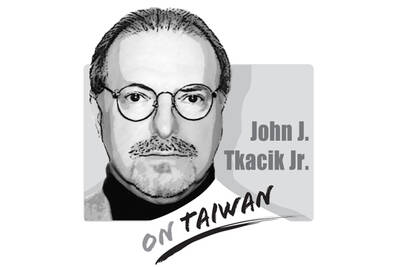A Bloomberg article last week about the loss of Taiwanese jobs to China has drawn mixed reactions. The article attributed the losses to the nation’s sluggish easing of investment rules and slow development of the service industry, saying these have caused Taiwan to fall behind Singapore and Hong Kong.
Some sources attributed job erosion to the government’s China policies, which they said helped domestic manufacturers relocate to China in the shortest time possible without creating jobs at home. Others said Taiwan was facing a labor shortage, rather than high unemployment, with the nation’s unemployment rate falling to 4.27 percent in May, its lowest level in 33 months, after peaking at 6.13 percent in August 2009.
One thing is clear: It is impossible to say that the nation’s unemployment problems have been solved, because the unemployment rate is still higher than pre-financial crisis levels.
An unemployment rate of 4.27 percent is indeed an improvement over one of 6.13 percent, but the government should not paint a rosy picture based on that number alone.
The public should keep in mind that the government’s definition of “unemployment” refers to people who are out of work, but ready to find jobs any time soon. “Discouraged workers,” who are not currently looking for jobs after having tried for a long time, and “non-typical workers,” such as part-time and temporary workers, however, do not fall into the government’s narrow definition of unemployment.
If the roughly 155,000 “discouraged workers” in May are added to the pool of 476,000 unemployed people for that month, the unemployment rate shoots up to 5.66 percent rather than the 4.27 percent reported by the government. In other words, just because certain people do not appear in the official unemployment statistics does not mean the labor market is improving.
Meanwhile, the nation is facing a serious problem of “structural unemployment,” an issue that Mark Williams, an economist at Capital Economics Ltd in London, rightfully pointed out in the Bloomberg article. Indeed, economists have long said that increasing structural unemployment is the main reason for rising unemployment and wage stagnation in Taiwan.
Over the past two decades, many labor-intensive manufacturers left Taiwan for other countries, causing the nation’s economy to go through structural adjustment as it shifts from traditional, labor-intensive industries to capitalized, technology-intensive industries. However, the labor force that lost jobs as traditional industries left Taiwan has failed to catch up with the nation’s industrial upgrade, with job seekers’ skills falling short of the demands of the new industries. Ironically, this has led to a skilled labor shortage and high unemployment occurring at the same time.
Structural unemployment is dangerous; it becomes more difficult to fix the longer it persists. This is because the longer people are out of work, the harder it is to find employment.
Moreover, structural unemployment not only results in a rising number of discouraged workers and shortage of skilled workers, but also restricts wage growth among salaried employees. This is because new industries lack the work force to sustain growth, while social welfare spending on the unemployed continues to expand, adversely affecting the competitiveness of the nation’s economy as a whole.
No matter what message people take from the Bloomberg article, no one should overlook structural unemployment and its implications for the nation’s economy — the paradox of high unemployment and a serious labor shortage, which we must tackle now.
A Chinese diplomat’s violent threat against Japanese Prime Minister Sanae Takaichi following her remarks on defending Taiwan marks a dangerous escalation in East Asian tensions, revealing Beijing’s growing intolerance for dissent and the fragility of regional diplomacy. Chinese Consul General in Osaka Xue Jian (薛劍) on Saturday posted a chilling message on X: “the dirty neck that sticks itself in must be cut off,” in reference to Takaichi’s remark to Japanese lawmakers that an attack on Taiwan could threaten Japan’s survival. The post, which was later deleted, was not an isolated outburst. Xue has also amplified other incendiary messages, including one suggesting
Chinese Consul General in Osaka Xue Jian (薛劍) on Saturday last week shared a news article on social media about Japanese Prime Minister Sanae Takaichi’s remarks on Taiwan, adding that “the dirty neck that sticks itself in must be cut off.” The previous day in the Japanese House of Representatives, Takaichi said that a Chinese attack on Taiwan could constitute “a situation threatening Japan’s survival,” a reference to a legal legal term introduced in 2015 that allows the prime minister to deploy the Japan Self-Defense Forces. The violent nature of Xue’s comments is notable in that it came from a diplomat,
Before 1945, the most widely spoken language in Taiwan was Tai-gi (also known as Taiwanese, Taiwanese Hokkien or Hoklo). However, due to almost a century of language repression policies, many Taiwanese believe that Tai-gi is at risk of disappearing. To understand this crisis, I interviewed academics and activists about Taiwan’s history of language repression, the major challenges of revitalizing Tai-gi and their policy recommendations. Although Taiwanese were pressured to speak Japanese when Taiwan became a Japanese colony in 1895, most managed to keep their heritage languages alive in their homes. However, starting in 1949, when the Chinese Nationalist Party (KMT) enacted martial law

“Si ambulat loquitur tetrissitatque sicut anas, anas est” is, in customary international law, the three-part test of anatine ambulation, articulation and tetrissitation. And it is essential to Taiwan’s existence. Apocryphally, it can be traced as far back as Suetonius (蘇埃托尼烏斯) in late first-century Rome. Alas, Suetonius was only talking about ducks (anas). But this self-evident principle was codified as a four-part test at the Montevideo Convention in 1934, to which the United States is a party. Article One: “The state as a person of international law should possess the following qualifications: a) a permanent population; b) a defined territory; c) government;